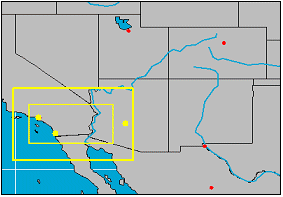 | To buffer a region around one or more selected features, use BUFFER inside a SPATIALQUERY. In this example, the Colorado River is buffered. <LAYER type="featureclass" name="theRiverBuffer" id="RivBuf"> <DATASET fromlayer="Rivers" /> <SPATIALQUERY where="NAME='Colorado'"> <BUFFER distance="80" bufferunits="MILES" /> </SPATIALQUERY> <SIMPLERENDERER> <SIMPLEPOLYGONSYMBOL fillcolor="255,255,0" filltransparency=".3" boundarycolor="255,255,0" boundarywidth="2" /> </SIMPLERENDERER> </LAYER> |
 | To select features from the same or another layer that fall within the buffer region, use TARGETLAYER as a child element. In this example, cities within 80 miles of the Colorado River are selected. (The buffer in the picture is shown for reference. With this request, only selected cities would display. To highlight the cities and show the buffer, both the following and preceding LAYER examples must be used in a request.) <LAYER type="featureclass" name="theRiverBuffer" id="RivBuf"> <DATASET fromlayer="Rivers" /> <SPATIALQUERY where="NAME='Colorado'"> <BUFFER distance="80" bufferunits="MILES" > <TARGETLAYER id="Cities" /> </BUFFER> </SPATIALQUERY> <SIMPLERENDERER> <SIMPLEMARKERSYMBOL color="255,255,0" width="6" /> </SIMPLERENDERER> </LAYER> |
 | To use a buffer as a selection tool. BUFFER is used around a defined filter within SPATIALFILTER. In this example, BUFFER is used to buffer around an envelope. The inner yellow box is the original envelope. The outer yellow box is the buffer filter. Note that these boxes would not normally display; only the selected items within the filter. <LAYER type="featureclass" name="theEvelopeBuffer" id="EnvBuf" > <DATASET fromlayer="Cities" /> <SPATIALQUERY where="POPULATION > 1000000" > <SPATIALFILTER relation="area_intersection"> <ENVELOPE minx="-119" miny="32" maxx="-113" maxy="35" /> <BUFFER distance="100" bufferunits="MILES" /> </SPATIALFILTER> </SPATIALQUERY> <SIMPLERENDERER> <SIMPLEMARKERSYMBOL color="255,255,0" width="6" /> </SIMPLERENDERER> </LAYER> |
- project the ENVELOPE for features returned in the target layer (GET_FEATURES envelope="true")
- project the global envelope for the returned features (GET_FEATURES globalenvelope="true")
- project geometry for features in the target layer (GET_FEATURES geometry="true")